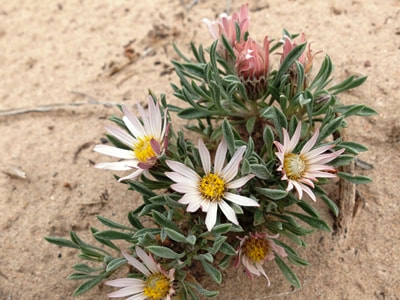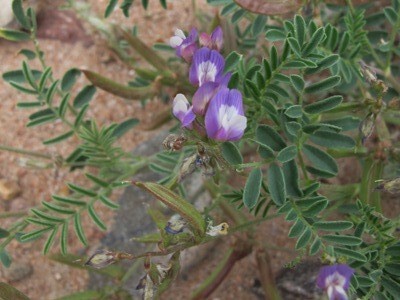|
The Bloom Blog Blooming this week in the environs of Abiquiú By Wildflowers of the Southern Rocky Mountains Found in dry, sandy areas
Seen blooming in May on CR 142 Painted Milkvetch is another of the many Astragalus species that grow in our area, identified by their seed pod rather than their flower or leaves. It is easily overlooked because it is so small and grows sprawling over the ground only a few inches high with narrow, folded, hairy, gray-green leaflets. The flowers are pink to purple and about ¼ inch long. The seed pods are inflated, mottled red and an inch long. The botanist who named it thought the pattern on the pods was ceramic-like. Traditionally, the Hopi dug up the sweet roots and gave them to children as candy. Source. If you trying to identify a different flower then you can check what other flowers bloom this month. If you cannot identify a flower from the website, send a photo and where you took it to [email protected]. Read online for tips.
0 Comments
The Bloom Blog Blooming this week in the environs of Abiquiú By Wildflowers of the Southern Rocky Mountains Found on dry, sandy, gravelly slopes
Seen blooming in May in Plaza Blanca Several species of Townsend Daisy can be found growing in our area. They are sometimes called Easter Daisies because they bloom around Easter time. Stemless Townsend Daisies grow in a low growing clump with slightly hairy, narrow, grayish leaves. Flowers are white to pinkish and one inch across often with a darker pink stripe on the back. The flowers grow directly from the root without a stem, hence its common name. Traditionally, the Blackfoot tribe gave a decoction of roots to tired horses to relieve them while the Navajo chewed or took an infusion of the plant to ease delivery, and used it to unravel ceremonial knots. Source. If you trying to identify a different flower then you can check what other flowers bloom this month. If you cannot identify a flower from the website, send a photo and where you took it to [email protected]. Read online for tips. The Bloom Blog Blooming this week in the environs of Abiquiú By Wildflowers of the Southern Rocky Mountains Found in sandy openings
Seen blooming in April in Plaza Blanca Turkey Peas stems grow from two to ten inches sprawling in a mat or erect. Stems are reddish and hairy. Leaves are on long stems and have 7-15 hairy leaflets. Tiny flowers, about 1/4 inch wide, have purple banners with a white center. Seed pods are red and slightly curved, about ½ inch long. No edible or medicinal uses were found on the internet, nor the reason for the common name Turkey Peas. A Google search found five other plants with the common name of Turkey Peas, multiple recipes using turkey and peas, and dog food. If you trying to identify a different flower then you can check what other flowers bloom this month. If you cannot identify a flower from the website send a photo and where you took it to [email protected]. Read online for tips. Spiny Blue Bowls, Desert Blue Gilia, Bluebowls Giliastrum acerosum Phlox Family (Polemoniaceae)4/16/2025 The Bloom Blog Blooming this week in the environs of Abiquiú By Wildflowers of the Southern Rocky Mountains Spiny Blue Bowls, Desert Blue Gilia, Bluebowls
Giliastrum acerosum Phlox Family (Polemoniaceae) Found in dry, open, gravelly areas Seen blooming in April in Poshuouinge, Santa Fe NF Although it grows only three to six inches tall Spiny Blue Bowls are noticeable because of their deep blue flowers. Flowers are ½ inch across with a bright yellow center. Leaves are needle-like and stems woody. Native Americans massaged the crushed plant on cramping muscles. Source. If you are trying to identify a different flower then you can check what other flowers bloom this month. If you cannot identify a flower from the website, send a photo and where you took it to [email protected]. Read online for tips. The Bloom Blog Blooming this week in the environs of Abiquiú By Wildflowers of the Southern Rocky Mountains Newberry’s Milkvetch
Astragalus newberryi var. newberryi Pea Family (Fabaceae) Found in sandy, dry areas Seen blooming in April on Chimney Rock Trail at Ghost Ranch This beautiful little plant grows low to the ground with 5 to 11 silky leaflets. Flowers are showy, bright pink/purple with a lighter center and are over one inch long. Seed pods are curved and covered in silky, white hairs. Traditional uses for Newberry’s Milkvetch are unknown, but other Milkvetch species have uses. The plant is considered poisonous, especially to stock and horses, however medicinally; a decoction of the whole plant was used as a wash for the head, hair and whole body, for stomach disorders, as a gargle for sore throats, a poultice of crushed leaves applied to a lame back, applied as an ointment for animals with urination troubles, roots were chewed as a cathartic, an infusion of root was used as a wash for sores and as a wash for granulated eyelids and toothaches, also plants were used as a ceremonial emetic, the seeds used for food, and pounded seeds mixed with other foods and used as a spice. Source. If you are trying to identify a different flower then you can check what other flowers bloom this month. If you cannot identify a flower from the website, send a photo and where you took it to [email protected]. Read online for tips. |
AuthorI am Marilyn Phillips, a native of England, whose love of nature and the outdoors from childhood brought me by a circuitous route to Crested Butte, Colorado in 1993 and 16 years later to northern New Mexico. My exploration of the many trails in these areas, my interest in wildflowers and photography, and career in computer system design came together in this creation. If you have any corrections, comments or questions, please contact me by email. Archives
September 2025
Categoriescopyright © 2020
|







 RSS Feed
RSS Feed